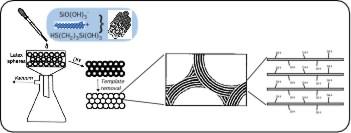During the last decade, much progress has been made in the bottom-updesign by a wide range of chemical techniques, including self-assembly, surfactant and polymer templating. Materials exhibiting a uniform arrangement of pores offer a wide variety of applications that are based on both the chemical properties of the solid matrix and properties specific to the pore size and arrangement. Porous materials have been classified according to their pore diameters. “Micropores” are those with diameters less than 2 nm, “mesopores” range from 2 nm to 50 nm, and “macropores” are greater than 50 nm in diameter. Microporous zeolites have found commercial applications as adsorbents, molecular sieves, and size or shape selective catalysts. Mesoporous silicates, prepared by surfactant templating or block-copolymer templating can be useful in chemical applications involving larger guest molecules, such as biological compounds. These materials possess high surface areas, ordered channel structures, and narrow pore size distributions. For most applications, however, the pore surfaces must be modified. We have developed several synthetic approaches that permit modification of the mesoporous sieve surface by direct syntheses. We have demonstrated that vinyl, thiol, and other organic functions can be incorporated in these well-ordered materials in-situ, and proved that they are located within the channels. We have also introduced a method of incorporating organic functional groups in the walls of the mesoporous support by using precursor molecules with two silicate units surrounding the organic group (bissilsesquioxanes).
To achieve larger pore sizes, we developed novel colloidal crystal templating techniques, which have been used by us and other researchers to produce three-dimensionally ordered macroporous (3DOM) solids composed of insulator, semiconductor, or metal compositions. We showed that it was possible to combine colloidal crystal templating with surfactant templating or zeolite synthesis to produce hierarchical structures: macroporous solids (200-800 nm pores) surrounded by silicate walls with mesopores (2-4 nm pores) or micropores (0.5 nm pores). Organic functional groups can also be introduced in these systems, which combine the selectivity and high surface areas due to the smaller pores with easy access through the macropores. Furthermore, it is possible to adjust other properties of the macroporous solids (e.g., catalytic properties) through functionalization and structuring of the walls.

Fig. 1. Schematic diagram of the preparation and structure of a porous silicate containing both macropores and mesopores with surface functional groups. Mesopores are produced by a surfactant templating process and macropores by colloidal crystal templating. The organic functional groups are introduced directly during the synthesis and are accessible for further reaction, such as uptake of heavy metal ions or introduction of dye molecules within the walls.

Fig. 2. SEM and schematic structure of a macroporous zeolite prepared by combining colloidal crystal templating with the use of a structure directing agent for the zeolite, silicate.The thin silicalite walls contain size-selective, 0.5 nm micropores with short diffusion paths, while the ca. 500 nm diameter macropores permit efficient transport of guest molecules.
We have studied the following systems in catalytic reactions:
- mesoporous and 3DOM silica functionalized with polyoxo-metalate clusters for epoxidation reactions
- mesoporous silica functionalized with titania clusters for photooxidation and thermal degradation of dye molecules
- mesoporous silica loaded with copper porphyrins for oxidative bleaching of dye molecules
- mesoporous silica functionalized with sulfonic acid groups for acid catalysis
- 3DOM alpha-alumina modified with silver for epoxidation of ethylene
- 3DOM sulfated zirconia for isomerization of butane